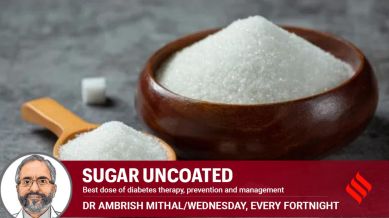A guide to control blood sugar spikes: How to read nutrition labels on processed foods?
Dr Ambrish Mithal, Chairman and Head, Endocrinology and Diabetes, Max Healthcare, gives some tips for understanding nutritional labels of packaged food.

The use of processed food, including “convenience” food, has gained widespread popularity in urban living. Convenience food, which is also called tertiary processed food, is commercially prepared for ease of consumption, and is usually ready to eat without further preparation. Such food always carries a nutrition label on the pack. For individuals with diabetes, understanding these nutrition labels is vital. So follow these tips:
Step 1 – Check the serving size and the per cent daily value
monthly limit of free stories.
with an Express account.
The serving size is at the top of the label. It may be listed by volume (one cup), weight (gms) or units (one cookie). Under that, the label will tell you the number of servings in the pack. Don’t assume that the whole pack is a single serving! The nutrition information listed on the label applies to one serving, not the whole pack. To get a total of calories and other nutrients for the entire package, multiply each of the numbers by the number of servings. For example, a popular biscuit packet usually states the serving size (three biscuits are nearly 27 gm) but the number of servings differ based on the size of the packet. You might eat two biscuits or even six! That is the portion size and you would need to estimate calories according to portion size consumed.
On the right side, you’ll see % daily value (DV). This shows how much of a certain nutrient is in a serving versus how much you need each day based on a 2,000 calorie diet. A DV of 5% or less means the food item is low in that nutrient and 20% or more means it is high in that nutrient. For example, if the % DV shows 4% dietary fibre, then the serving size contains 4% of the fibre you should eat that day if you are on a 2,000 calorie diet.
Step 2 – List of Ingredients
Ideally, every product should have a complete list of all the ingredients. The ingredient that is maximum in amount is usually listed at the top, and then it is in descending order, with the one present in the least amount at the bottom.
Step 3 – Make sure the product is not high in saturated fat, trans fats or sodium
Saturated fat, trans fats, sodium and sugar are nutrients listed on the label that are associated with adverse health outcomes.
- Dietary Fats – Two types of dietary fats, saturated and trans fats, are linked to an increased risk of heart disease. People with diabetes should try to limit calories from saturated fat to <7% and trans-fat to <1% in your diet. Remember, “partially hydrogenated oil” contains trans fat.
- Sodium – Limiting the amount of salt you eat to less than 5g/day is recommended. A teaspoon of salt contains 2300 mg of sodium. Salt is listed as sodium on a nutrition label. Try to stay away from foods that have more than twice the milligrams of sodium than calories per serving.
Step 4 – Check the carbs
Total carbohydrates are divided into two categories on a label, dietary fibre and sugar.
- Dietary fibre – Foods with at least three grams of fibre per serving are considered a good source of this important nutrient.
- Sugar alert – “NO added sugar” does not mean sugar free! The food item can have sugar alcohols (sorbitol, xylitol, erythritol) or could contain products which are rich in naturally occurring sugar. For example, fruit juice contains natural sugars but that does not make it healthy! In fact, WHO classifies the sugar in juice as “free sugars” like in cold drinks. Similarly, a cereal box may say “no added sugar” but the cereal may be coated with honey. Sugars could also be hidden in corn syrup, fructose, maltose, dextrose or cane syrup. Remember : Total sugar on nutrition label includes natural and added sugars- sugars that are added during processing of the food such as sucrose, dextrose.